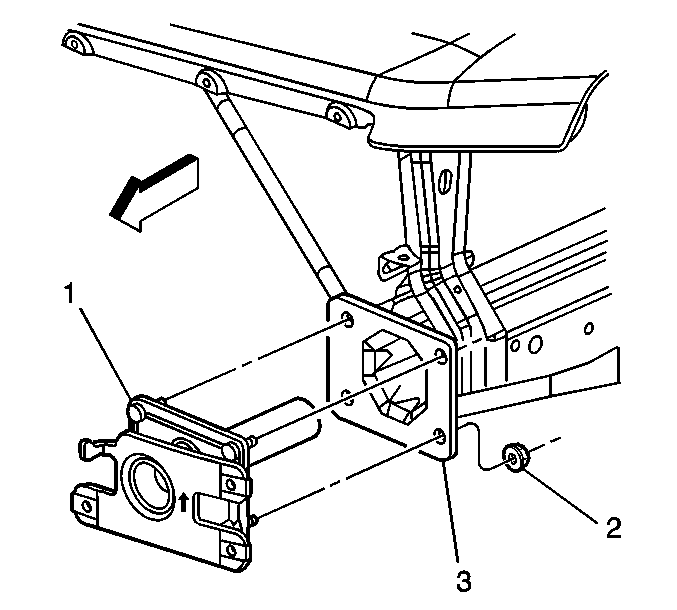Removal Procedure
- Remove the front impact bar. Refer to Front Bumper Impact Bar Replacement .
- Remove the bolts (2) securing the front end diagonal brace to the hood latch bracket assembly and to the energy absorber unit.
- Remove the diagonal brace (1).
- Remove the nuts (2) securing the energy absorber (1) to the frame rail (3).
- Remove the energy absorber (1) from the frame rail by pulling outward.
Caution: Failure to observe the following procedure when handling energy absorbers
could cause personal injury.
• Do not apply heat to an energy absorber. • Do not weld in the area of an energy absorber. • Do not attempt to repair a damaged energy absorber. Always replace
the damaged energy absorber with a new part. • If an energy absorber is bound-up as a result of a collision such
that it cannot extend, take precautions to avoid spring-back when bending
sheet metal. Provide a positive restraint, such as a chain or cable to hold
the bumper in the position it is in. Wear approved safety glasses and using
a 3mm (1/8 inch) drill bit, drill a small hole in the piston tube near the
bumper bracket to relieve gas pressure. Remove the energy absorber after
gas pressure has been relieved. • If an energy absorber is to be scrapped, relieve the gas pressure
prior to disposal of the part. Make an indentation with a center punch in
the small cylinder section of the energy absorber.


Installation Procedure
- Install the energy absorber (1) to the frame rail (3).
- Position the diagonal brace (1) to the hood latch bracket assembly, and to the stud on the backside of the energy absorber.
- Install the energy absorber nuts (2).
- Install the front impact bar. Refer to Front Bumper Impact Bar Replacement .

Important: The arrow on the energy absorber (1) needs to be positioned upward prior to installation.

Notice: Use the correct fastener in the correct location. Replacement fasteners must be the correct part number for that application. Fasteners requiring replacement or fasteners requiring the use of thread locking compound or sealant are identified in the service procedure. Do not use paints, lubricants, or corrosion inhibitors on fasteners or fastener joint surfaces unless specified. These coatings affect fastener torque and joint clamping force and may damage the fastener. Use the correct tightening sequence and specifications when installing fasteners in order to avoid damage to parts and systems.
Tighten
Tighten the nuts to 25 N·m (18 lb ft).
